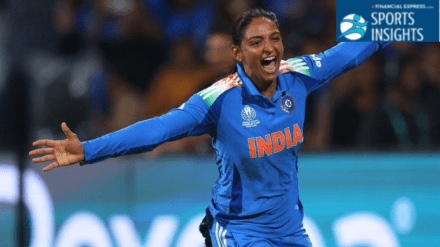When a 21-year-old Harmanpreet Kaur made her debut against Pakistan in a World Cup match in 2009, women’s cricket in India was still treated like an afterthought. Matches weren’t televised. Grounds were half-empty. Facilities were basic at best.
Players weren’t chasing fame; they were chasing recognition.
Harman was a young girl from Moga, Punjab; playing for a team that barely had resources to train properly. Yet, what she carried within her was rare: belief. The kind of belief that grows only in silence, away from applause.
Four years later, when India hosted the 2013 World Cup, things hadn’t improved much. Harman still had to make peace with the fact that the men’s game drew headlines while the women’s team quietly boarded economy flights. India crashed out early that year, but Harman stood tall, finishing as the team’s top run-getter. That tournament might’ve been a disappointment for the team, but for her, it was a statement: she wasn’t going anywhere.
Turning Point: The Knock That Shook The System
2017 was the year everything changed.
India’s women were in the World Cup semi-final against Australia; the most dominant team in the sport. Early wickets fell. Pressure mounted. And then walked in Harmanpreet Kaur, visibly struggling with cramps and injuries, but batting like a storm in human form.
What followed was one of the greatest innings ever played by an Indian in a World Cup – men’s or women’s. 171 not out off 115 balls. Power. Timing. Madness. Art.
She later said, half-smiling, “Sir, I was cramping so much, I had to hit sixes because I couldn’t run.” What she didn’t say was that this knock changed everything – sponsorships, coverage, salaries, respect. It made people stop scrolling, stop switching channels, and actually watch women’s cricket.
she played on a half-empty stomach because the team hotel had messed up breakfast. The players had samosas before the biggest game of their lives. And yet, she scored the kind of innings that fed the dreams of millions.
Vinod Rai, then head of BCCI’s Committee of Administrators, later admitted his regret; that women’s cricket was ignored for too long. He revealed how, before that period, even the players’ jerseys were made by cutting up men’s uniforms and stitching them smaller. It was that bad.
After 171*, that neglect became impossible to justify.
The Numbers That Tell The Story
For all the fame that one innings brought, people often forget how consistent Harmanpreet has been. She isn’t just the face of one miracle match; she’s the spine of Indian women’s cricket.
She has played seven semifinal or final matches in her career. Her average in those games? A ridiculous 103.25. Three of her seven ODI hundreds have come in World Cups. No other woman cricketer has scored more World Cup runs than her with a better average & a better strike rate.
And she’s done all this while mostly batting in the middle order; positions four and five; where innings die more often than they bloom. From there, she’s scored more than 4000 runs, the most by any woman in the world.
It’s no coincidence. It’s grit, shaped by years of having to prove her worth again and again.
The Rise: From Silence To Stadium Roars
The 2017 final may have ended in heartbreak, but it sparked a revolution. More than 120 million Indians watched it live. Young girls started picking up bats and balls, not because they wanted to be “like Virat Kohli,” but because they wanted to be Harmanpreet Kaur.
Since then, India’s women’s team has reached the finals of 2020 T20 World Cup, 2022 Commonwealth Games, and 2024 Asia Cup. They lost all three, but each time, Harman stood in front of cameras, steady and proud, saying, “We’ll cross the line next time.”
The Moment That Changed Everything
And she did.
The 2025 ODI World Cup; her fifth, but the first as captain on home soil; became the story she’d been waiting to finish. India stumbled early but held their nerve, beat Australia in the semis again, and then conquered South Africa in the final.
When the last catch landed in Harman’s hands, she looked up, almost in disbelief. Years of pain, loss, and effort folded into one quiet smile.
In the press room, still trying to process it, she said, “I’m numb. I can’t explain. We just believed. We kept believing.”
The Girl Who Made The World Look
Harmanpreet Kaur was born on Women’s Day in 1989, as if the date itself knew what she was meant to become. From dusty grounds in Punjab to packed stadiums, from hand-me-down kits to designer jerseys, she saw Indian women’s cricket crawl, stumble, and finally soar.
She didn’t just play for runs or records. She played for a place; for a generation of girls who now know they belong here.
When people say, “He is him,” cricket found its answer in her.
Because Harmanpreet Kaur didn’t wait for women’s cricket to change. She became the reason it did.
